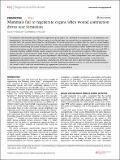Notice
This is not the latest version of this item. The latest version can be found at:https://dspace.mit.edu/handle/1721.1/139760.2
Mammals fail to regenerate organs when wound contraction drives scar formation
| dc.contributor.author | Yannas, Ioannis V | |
| dc.contributor.author | Tzeranis, Dimitrios S | |
| dc.date.accessioned | 2022-01-26T19:49:51Z | |
| dc.date.available | 2022-01-26T19:49:51Z | |
| dc.date.issued | 2021 | |
| dc.identifier.uri | https://hdl.handle.net/1721.1/139760 | |
| dc.description.abstract | Abstract To understand why mammals generally do not regenerate injured organs, we considered the exceptional case of spontaneous skin regeneration in the early lamb fetus. Whereas during the early fetal stage skin wounds heal by regeneration, in the late fetal stage, and after birth, skin wounds close instead by scar formation. We review independent evidence that this switch in wound healing response coincides with the onset of wound contraction, which is also enabled during late fetal gestation. The crucial role of wound contraction in determining the wound healing outcome in adults has been demonstrated in three mammalian models of severe injury (excised guinea pig skin, transected rat sciatic nerve, excised rabbit conjunctival stroma) where grafting the injury with DRT, a contraction-blocking scaffold of highly-specific structure, altered significantly the wound healing outcome. While spontaneous healing resulted in scar formation in these animal models, DRT grafting significantly reduced the extent of wound contraction, prevented scar synthesis, and resulted in partial regeneration. These findings, as well as independent data from species that heal spontaneously via regeneration, point to a striking hypothesis: The process of regeneration lies dormant in mammals until appropriately activated by injury. In spontaneous wound healing of the late fetus and in adult mammals, wound contraction impedes such endogenous regeneration mechanisms. However, engineered treatments, such as DRT, that block wound contraction can cancel its effects and favor wound healing by regeneration instead of scar formation.</jats:p> | en_US |
| dc.language.iso | en | |
| dc.publisher | Springer Science and Business Media LLC | en_US |
| dc.relation.isversionof | 10.1038/S41536-021-00149-9 | en_US |
| dc.rights | Creative Commons Attribution 4.0 International license | en_US |
| dc.rights.uri | https://creativecommons.org/licenses/by/4.0/ | en_US |
| dc.source | Nature | en_US |
| dc.title | Mammals fail to regenerate organs when wound contraction drives scar formation | en_US |
| dc.type | Article | en_US |
| dc.identifier.citation | Yannas, Ioannis V and Tzeranis, Dimitrios S. 2021. "Mammals fail to regenerate organs when wound contraction drives scar formation." npj Regenerative Medicine, 6 (1). | |
| dc.relation.journal | npj Regenerative Medicine | en_US |
| dc.eprint.version | Final published version | en_US |
| dc.type.uri | http://purl.org/eprint/type/JournalArticle | en_US |
| eprint.status | http://purl.org/eprint/status/PeerReviewed | en_US |
| dc.date.updated | 2022-01-26T19:47:27Z | |
| dspace.orderedauthors | Yannas, IV; Tzeranis, DS | en_US |
| dspace.date.submission | 2022-01-26T19:47:28Z | |
| mit.journal.volume | 6 | en_US |
| mit.journal.issue | 1 | en_US |
| mit.license | PUBLISHER_CC | |
| mit.metadata.status | Authority Work and Publication Information Needed | en_US |
